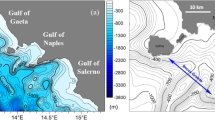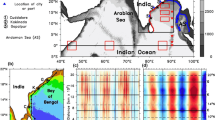Abstract
The residual (time-average) salinity and circulation in a numerical ocean model of the Tampa Bay estuary are shown to experience significant temporal variation under realistic forcing conditions. A version of the Estuarine Coastal Ocean Model developed for Tampa Bay with 70 by 100 horizontal grid points and 11 sigma levels is examined for the years 2001–2003. Model output variables are averaged over the entire time of the simulation to generate long-term residual fields. The residual axial current is found to be dominated by the buoyancy-driven baroclinic circulation with an outflow (southwestward) at the surface and to the sides of the shipping channel, and an inflow (northeastward) usually occurring subsurface within or above the shipping channel. Averages over 30 d are used to examine variations in the residual fields. During the simulation the average surface salinity near the head of Tampa Bay varies with the freshwater inflow, from 12‰ to 33%. At the bay mouth salinity varies from 30%. to 36%.. A localized measure of the baroclinic circulation in the shipping channel indicates the residual circulation can vary strongly, attaining a magnitude triple the long-term mean value. The baroclinic circulation can be disrupted, going to near zero or even reversing, when the buoyancy-driven flow is weak and the surface winds are to the northeast. Three time periods, representing different environmental conditions, are chosen to examine these results in detail. A scaling argument indicates the relative strength of buoyancy versus wind as ΔρgH2(LC Dω2)−1, where δρ is head-to-mouth density difference across the bay,g is gravitational acceleration,H is depth,L is bay length,C D is the surface wind drag coefficient, andw is wind speed. Tampa Bay is usually in the buoyancy dominated regime. The importance of winds in the weak-buoyancy case is demonstrated in an additional simulation without wind stress.
Similar content being viewed by others
Literature Cited
Aelbrecht, D., G. C. D’Hières, andD. Renouard. 1999. A 3-D coastal tidal rectification process: Observations, theory and experiments.Continental Shelf Research 19:1869–1903.
Blumberg, A. F. andG. L. Mellor. 1987. A description of a three-dimensional coastal ocean circulation model, p. 1–16.In N. S. Heaps (ed.), Three-Dimensional Coastal Models, Volume 4. American Geophysical Union, Washington, D.C.
Brooks, G., D. Thomas, and L. Doyle. 1993. Groundwater/ surface water interactions in Tampa Bay and implications for nutrient fluxes. Prepared for: Tampa Bay National Estuary Program, St. Petersburg, Florida.
Burwell, D. 2001. Modeling Eulerian and Lagrangian Estuarine Residence Times. Ph. D. Dissertation University of Florida, St. Petersburg, Florida.
Caceres, M., A. Valle-Levison, and L. Atkinson. 2003. Observations of cross-channel structure of flow in an energetic tidal channel.Journal of Geophysical Research 108: doi 10.1029/ 2001JC000968.
Galperin, B., A. F. Blumberg, and R. H. Weisberg. 1991. A timedependent three-dimensional model of circulation in Tampa Bay, p. 67–75.In S. Treat and P. Clark (eds.), Proceedings Tampa Bay Area Scientific Information Symposium 2. Tampa, Florida.
Goodwin, C. R. 1987. Tidal flow, circulation, and flushing changes caused by dredge and fill in Tampa Bay, Florida. U.S. Geological Survey, Water Supply Paper 2282, Tampa, Florida.
Hsien-Wang, O. 1999. A model of tidal rectification by potential vorticity mixing. Part I: Homogeneous ocean.Journal of Physical Oceanography 29:821–827.
Kjerve, B., H. E. Seim, A. F. Blumberg, andL. D. Wright. 1992. Modelling of the residual circulation in Broken Bay and the Lower Hawkesbury River, NSW.Australian Journal of Marine Freshwater Research 43:1139–1357.
Kroeger, K. D., P. W. Swarzenski, W. J. Greenwood, andC. Reich. 2007. Submarine groundwater discharge to Tampa Bay: Nutrient fluxes and biogeochemistry of the coastal aquifer.Marine Chemistry 104:85–97.
Lee, S. H. andR. C. Beardsley. 1999. Influence of stratification on residual tidal currents in the Yellow Sea.Journal of Geophysical Research 104:15679–15702.
Levine, A. D., M. T. Meyers, V. J. Harwood, V. Chivukula, G. Kish, and P. Hauck. 2003. Preliminary study of the potential for using multiple effect distillation for treatment of reclaimed water. Phase I: Evaluation of the distribution of pharmaceuticals, hormones, household and industrial chemicals during wastewater treatment at the Howard F. Curren Advanced Wastewater Treatment Facility, City of Tampa, Tampa, Florida.
Li, Z. 1993. Circulation of Tampa Bay in relation to tides, winds and buoyancy driven convection. M.S. Thesis, University of South Florida, Tampa, Florida.
Li, M., A. Gargett, andK. Denman. 1999. Seasonal and interannual variability of estuarine circulation in a box model of the Strait of Georgia and Juan de Fuca Strait.Atmospheric Oceanography 37:1–19.
Li, C. andJ. O’Donnel. 1997. Tidally driven residual circulation in shallow estuaries with lateral depth variations.Journal of Geophysical Research C13:27915–27979.
MacCready, P. 1999. Estuarine adjustment to changes in river flow and tidal mixing.Journal of Physical Oceanography 29:708–726.
MacCready, P. 2004. Toward a unified theory of tidally-averaged estuarine salinity structure.Estuaries 27:561–570.
Matsuura, H. andG. A. Cannon. 1997. Wind effects on sub-tidal current in Puget Sound.Journal of Oceanography 53:53–66.
Mellor, G. L. andT. Yamada. 1982. Development of turbulence closure model for geophysical fluid problems.Review of Geophysical and Space Physics 20:851–875.
Montero, P., M. Gomez-Gesteira, J. J. Taboada, M. Ruiz-Villareal, A. P. Santos, R. R. Neves, andV. Perez-Villar. 1999. On residual circulation of the Ria of Vigo using a 3-D baroclinic model.Boletin Instituto Espanol de Oceanografia 15:31–38.
Pritchard, D. W. 1956. The dynamic structure of a coastal plane estuary.Journal of Marine Research 15:33–42.
Rattray, Jr.,M. andD. V. Hansen. 1962. A similarity solution for circulation in an estuary.Journal of Marine Research 20:121–133.
Reed, R. E., H. B. Glasgow, J. M. Burkholder, andC. Brownie. 2004. Seasonal physical-chemical structure and acoustic Doppler current profiler flow patterns over multiple years in a shallow, stratified estuary, with implications for lateral variability.Estuarine Coastal Shelf Science 60:549–566.
Robbins, B. D. 1997. Quantifying temporal change in seagrass areal coverage: The use of GIS and low resolution aerial photography.Aquatic Botany 58:259–267.
Robinson, I. S. 1981. Tidal vorticity and residual circulation.Deep Sea Research 28:195–212.
Smagorinsky, J. 1963. General circulation experiments with the primitive equations, 1: The basic experiment.Monthly Weather Review 91:99–164.
Sopkin, K., C. Mizak, S. Gilbert, V. Subramanian, M. E. Luther, andN. Poor. 2007. Modeling Air/Sea Flux Parameters in a Coastal Area: A Comparative Study of Results from the TOGA COARE Model and the NOAA Buoy Model.Atmospheric Environment 41:4291–4303.
Stacey, M. T., J. R. Burau, andS. G. Monismith. 2001. Creation of residual flows in a partially stratified estuary.Journal of Geophysical Research 106:17013–17038.
Talbot, D. andJ. M. Lawrence. 2002. The effect of salinity on respiration, excretion, regeneration and production inOphiophragmus filograneus (Echinodermata: Ophiuroidea).Journal of Experimental Marine Biology and Ecology 275:1–14.
Valle-Levinson, A., C. Reyes, andR. Sanay. 2003. Effects of bathymetry, friction, and rotation on estuary-ocean exchange.Journal of Physical Oceanography 33:2375–2393.
Vincent, M. S. 2001. Development, Implementation and Analysis of the Tampa Bay Coastal Prediction System. Ph.D. Dissertation, University of South FloridaTampa, Florida.
Weisberg, R. H. and L. Zheng. 2006. The circulation of Tampa Bay driven by buoyancy, tides, and winds, as simulated using a finite volume coastal ocean model.Journal of Geophysical Research 111:C01005, doi:10.1029/2005JC003067.
Wilson, M., S. D. Meyers, andM. E. Luther. 2006. Changes in the circulation of Tampa Bay due to Hurricane Frances as recorded by ADCP measurements and reproduced with a numerical ocean model.Estuaries and Coasts 29:914–918.
Winant, C. D. andG. G. DeVelasco. 2003. Tidal dynamics and residual circulation in a well-mixed inverse estuary.Journal of Physical Oceanography 33:1365–1379.
Wong, K. C. 1994. On the nature of transverse variability in a coastal plain estuary.Journal of Geophysical Research 99:14209–14222.
Yanagi, T. 1999. Coastal Oceanography, 1st edition. Terra Scientific Publishing, Tokyo, Japan.
Yanagi, T. andK. Yoshikawa. 1983. Generation mechanisms of tidal residual circulation.Journal of Oceanography 39:156–166.
Yong, H. K. andG. Voulgaris. 2005. Effect of channel bifurcation on residual estuarine circulation: Winyah Bay, South Carolina.Estuarine Coastal Shelf Science 65:671–686.
Author information
Authors and Affiliations
Corresponding author
Rights and permissions
About this article
Cite this article
Meyers, S.D., Luther, M.E., Wilson, M. et al. A numerical simulation of residual circulation in Tampa Bay. Part I: Low-frequency temporal variations. Estuaries and Coasts: J ERF 30, 679–697 (2007). https://doi.org/10.1007/BF02841965
Received:
Revised:
Accepted:
Issue Date:
DOI: https://doi.org/10.1007/BF02841965




